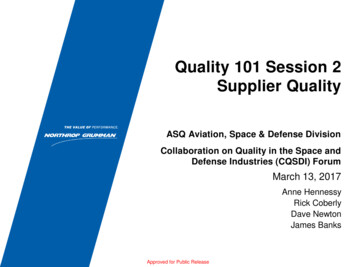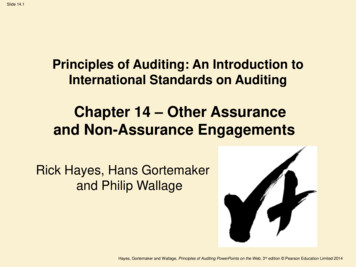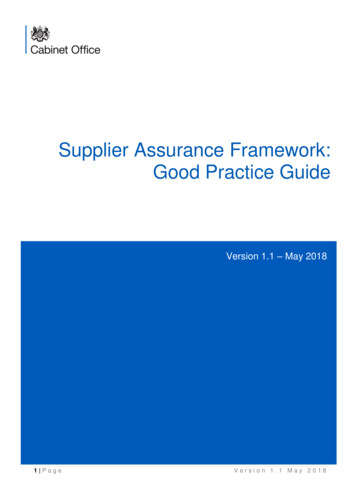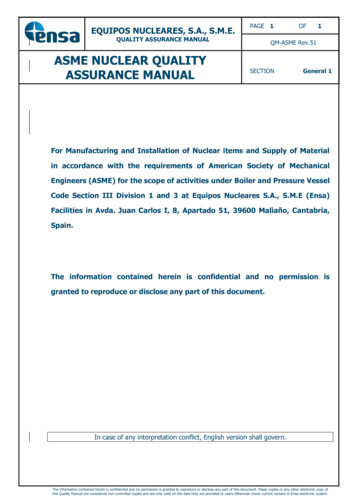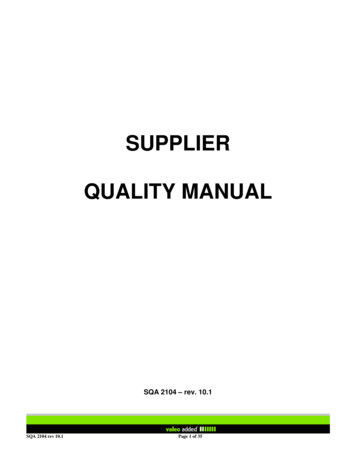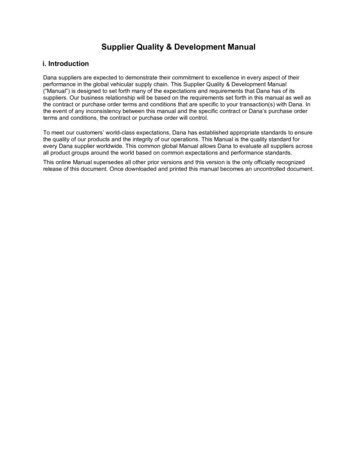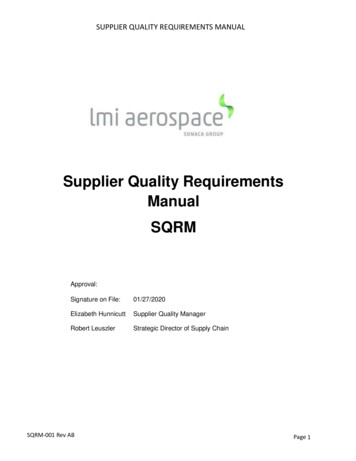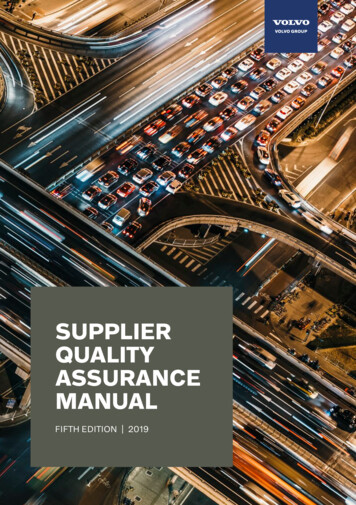
Transcription
SUPPLIERQUALITYASSURANCEMANUALFIFTH EDITION 2019Safety management 1
INTRODUCTIONDELIVERING EXCEPTIONAL PERFORMANCEFOR OUR CUSTOMERSQuality lasts when we put it first. Every day in the Volvo Group,we are relentlessly working to improve our processes, products andcompetences to be best in class in our industry. Equally importantis the spirit of true commitment to quality excellence, having acustomer-focused approach at heart and a continuous improvementmindset. This is where you as our supplier and business partnercome into the picture. We expect and encourage you to adoptthe same principles, practices and mindset. Both today, with yourunbeatable knowledge of well-known technologies, and yourcompetitive curiosity for tomorrow’s innovations.Quality lies in everything we do. You are selected to deliver theright products and/or services in terms of Quality, Delivery, Cost,Features, Technology, Sustainability, and Risk Management, knownas our “QDCFTSR”. But it is beyond all checklists that we cantruly create value for the Volvo Group and be capable of deliveringexceptional performance for our customers – now and in the future.This manual describes the expectations,requirements, formal guidelines andpractices expected of you as our supplierfor Volvo Trucks, Mack Trucks, RenaultTrucks, UD Trucks, Eicher Trucks, VolvoBus, Nova Bus, Prevost Bus, VolvoConstruction Equipment, and Volvo Penta.With this as our common ground, we candevelop and maintain a strong, stable,structured, long-term and successfulpartnership where we proactively andpredictively secure zero defects, zerodelays and zero waste together.ANDREA FUDERCHIEF PURCHASINGOFFICER, VOLVO GROUP
Contents6. Volvo Group specific requirements.51Using this document. 6OrganizationKey Element ProceduresScopeVolvo Group Supplier PortalSupplier feedback1. Safety management. 91.1 Definition1.2 Responsibility1.3 Identification of safety characteristics1.4 Production and functional requirements1.5 Safety Management Audit1.6 Lot traceability requirements1.7 Pass through parts requirements2. Basic requirements.172.1 Performance expectations2.2 Management systems requirements3. Sourcing. 233.1 Quality Management System requirements3.2 Short Supplier Evaluation Model3.3 Confidentiality agreement3.4 Request for Quotation3.5 Supplier Evaluation Model3.6 Index audits3.7 Corporate Social Responsibility3.8 Final agreement4. Advanced Product Quality Planning. 294.1 Advanced Product Quality Planning4.2 Responsibilities in APQP4.3 Key Components4.4 APQP reviews4.5 Software APQP5. Production Part Approval Process. 395.1 Reference5.2 Process5.3 Significant Production Run5.4 Documentation requirements5.5 Approval of software6.1 Review of Technical Specification6.2 Product Application Agreement6.3 Part Handling Review6.4 Special characteristics6.5 Legal requirements and Conformity of Production6.6 Cleanliness requirements6.7 Prototype parts and CPOT-IPD6.8 REACH compliance and IMDS reporting6.9 Pre-launch control plans6.10 Service parts requirements6.11 Functional safety requirements6.12 System- or organizational changes7. Production requirements. 737.1 Product or Process Change Notification7.2 Requesting deviations to specifications7.3 Lot traceability7.4 First In First Out inventory control7.5 Sub-tier supplier requirements7.6 Packaging7.7 Warranty7.8 Laboratory requirements7.9 Record retention8. Performance measurements and corrective actions. 838.1 Non-conforming material8.2 Corrective action response8.3 Supplier scorecard8.4 PPM and Quality Performance Measurement8.5 The Volvo Group process audit8.6 Continuous improvements8.7 Supplier improvement programs8.8 Field quality issuesGlossary. 98Revision record. 100Concluding words. . . 101
Using this cingAPQPPPAP6.7.Volvo erformancemeasurementsand correctiveactionsOrganizationThis document defines the expectations and working proceduresintended to assist suppliers in achieving and maintaining asuccessful working business relationship with the Volvo Group.This document is organized in eight chapters explaining our mainprocesses.Key Element ProceduresIn addition to this Supplier Quality Assurance Manual, Volvo Groupmaintains a set of procedures that define specific requirements andexpectations in key areas. These Key Element Procedures coverVolvo Group requirements related to the environment, corporatesocial responsibility, logistics and cost management. The KeyElement Procedures are available on the Volvo Group SupplierPortal. Always contact the Volvo Group Buyer or Supplier QualityEngineer* if you have questions related to our procedures andrequirements.* At Volvo Construction Equipment the Supplier Quality Engineers(SQE) is called Supplier Development Engineers (SDE).ScopeThis Supplier Quality Assurance Manual is a joint documentrecognized and used by the following organizations: Volvo Trucks,Mack Trucks, Renault Trucks, UD Trucks, Eicher Trucks, Volvo Bus,6 Using this documentNova Bus, Prevost Bus, VolvoConstruction Equipment andVolvo Penta. Nova Bus andPrevost Bus may be referredto as Volvo Bus NorthAmerica (VBNA).Text in frame boxes like thisprovide an overview of theinformation in the sectionand may be used as a quickreference.To simplify the text in thisdocument, the name Volvo Group refers to this collective group ofcompanies. The word Vehicle may refer to both trucks and buses.MANDATORY REQUIREMENTS ARE HIGHLIGHTED IN THISFORMATVolvo Group Supplier PortalVolvo Group Supplier Portal is the web entry point on www.volvogroup.com/suppliers, which enables collaboration betweenVolvo Group and its suppliers as well as business partners. Theportal allows suppliers to access all relevant documents and newsneeded to collaborate efficiently. Suppliers are responsible forapplying for access to Volvo Group Supplier Portal by contacting theBuyer or cmsservices@volvo.comUsing this document 7
Suppliers are required to maintain the contact details for keyindividuals and business information for their organization. Toensure timely and accurate information, authorized suppliers areresponsible for maintaining the supplier’s information on VolvoGroup Supplier Portal and have the ability to grant access. Anauthorized supplier contact can add, edit, delete and manage theirown employee’s access rights to our system and applications whenorganizational changes occur.It is recommended to review the contact information at least everysix months. This will help to ensure the effective exchange ofimportant information.1.SAFETYMANAGEMENTPROTECTING THE CUSTOMERAdditional guidelines, communication kits, and templates are postedin the Quality section of the Library on the Volvo Group SupplierPortal. The latest version of this Supplier Quality Assurance Manualis also available there.Supplier feedbackWe welcome and encourage feedback concerning this document.Any suggestions, including suggestions for adding additionalinformation or improvements to this document, should be e-mailedto onand ilityrequirementsPass throughpartsrequirementsFrom the founding of Volvo in the 1920’s, quality and safetyhave been core values of the corporation. Since that time, thecommitment to the research and development of new and oftenunique safety solutions has made the Volvo name synonymous withsafety around the world.Today, Quality, Safety and Care for the Environment continue to bethe core values of the Volvo brands and form a foundation for allbusiness practices including the cooperation between the VolvoGroup and our suppliers.The Volvo Group definition of safety not only includes the safetyof the immediate user of our products, but also understanding theentire scope of potential impact of our products on society.The primary objective is to develop products that assist inpreventing accidents from occurring or, in the event an accident8 Using this document1. Safety management 9
does occur, to minimize the consequences for the drivers and otherson the road.The supplier’s contribution to safety lies in developing innovativesolutions, implementing safety features and producing fullyconforming products. The Volvo Group Safety ManagementProgram focuses on both suppliers’ management systems, andproduct quality related to safety.Safety Management applies to a part, function or feature whena non-conformance related to the product would create a safetyhazard.1.1 DefinitionSafety requirements are determined based on the potential of afeature, product or system to create a personal hazard to any personin contact with the products or effects caused by the product. ASafety Customer Effect is considered when a danger can lead toinjuries to vehicle operators, passengers, other travelers, passersby or maintenance personnel. Suppliers of a safety critical part arecategorized as a Safety Part Supplier.Historically, Volvo Group defined safety critical parts by the featureof the part. Recently, Volvo Group defineds a new classification ofsafety parts based on the use, function or application of the part.There is no single feature or characteristic of the part that defines thepart as safety critical, rather the safety critical designation relates tothe safe reliable function of the part itself. These parts shall meet allthe requirements of a safety critical part with the exception of therequirement to maintain capability of a specific feature.Suppliers of parts on the list of safety parts will be notified by thepresence of a check box on the Part Version Report (PVR) or bynotification from the Supplier Quality Engineer (SQE) assigned forthe component.Safety Critical related features are designated by the presence ofthe symbol [CC] or [1] next to the feature on the drawing or in aspecification. If any feature of a part is considered safety critical,the part is considered to be a safety critical part. All of the activities10 1. Safety managementrelated to safety management are required if any feature of a part isidentified as having an impact on safety, and the part is consideredsafety critical.1.2 ResponsibilityThe production of safe, fully conforming products to the VolvoGroup companies is the supplier’s responsibility and is part of thesupplier’s contractual commitment. Any assistance provided byVolvo Group does not in any way limit the supplier’s responsibilityto supply parts that conform to all technical specifications andstandards, as well as regulatory, contractual and legal demands.Suppliers are required to conduct a criticality analysis for features ofthe product design and production process that could result in a safetyeffect. For suppliers having design responsibility, special characteristicsrelated to safety must be clearly identified within their designspecifications, verification/validation plans, drawings and technicaldocumentation. Suppliers who are design responsible for productsimpacting safety are required to develop System, Sub-System, Designand Process Failure Modes Effects Analysis to assist in the analysis.Volvo Group must be notified of any product features or functionswhere the potential failure mode and associated customer safetyeffect are assigned a high severity score (9 or 10). (Severity for anyfeatures identified by Volvo Group with a [CC] or [1] must have aseverity score of a 9 or 10 on the supplier’s FMEA.)Suppliers are responsible to ensure that all sub-suppliers andcontractors are aware of and comply with the requirements relatedto safety requirements. Tier I suppliers must have procedures andpractices to ensure an adequate level of control and requirementsare deployed at all suppliers or sub-suppliers whose product orprocesses could have an effect on safety related features.VOLVO GROUP MUST BE NOTIFIED IMMEDIATELY IN THEEVENT A NON-CONFORMANCE OR POTENTIAL CUSTOMERRISK IS IDENTIFIED1. Safety management 11
1.3 Identification of safety characteristicsA safety critical characteristic is identified when non-compliancewith the requirement has the potential to lead to a Customer Safetyeffect.A new Volvo Group standard for identifying and grading criticalcharacteristics, STD 105-0007 “Special Characteristics Definitionand Application” has been released and is effective for allVolvo Group drawings, functional requirements and TechnicalRequirements. Drawings, Functional Requirements or TechnicalRequirements developed before 1 Sept 2015 may follow VolvoGroup standard STD 105-0001 “Critical Characteristics of DesignProducts – Identification & Grading”.The methods used for marking lot/serial numbers on safetycritical parts must support identification, traceability and failureinvestigation through all phases of the product’s life. In principle,the serial number or lot number should be applied to the actual partand preferably should be easily visible when mounted on the vehicle.When feasible, the [CC] symbol must be included on the part label.This would apply if the drawing is marked with a [CC] or [1] symbol.Unless otherwise specified in product documentation, the preferredmethod for marking is: Item serializationassociated documentation such as Process FMEA, control plans andwork instructions.Capability requirements for parts identified with [CC], [1]characteristics are described below:Critical Characteri
8.5 The Volvo Group process audit 8.6 Continuous improvements 8.7 Supplier improvement programs 8.8 Field quality issues Glossary . 98 Revision record . 100 Concluding words. 101 Contents Using this document. 6 Organization Key Element Procedures Scope Volvo Group Supplier Portal Supplier feedback 1. Safety management. 9 1.1 Definition 1.2 Responsibility 1.3 Identification .





